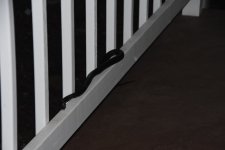I think you all are way too calm about this herpetology thing. Here, let me fix this for you.
-
Happy Birthday, Stan "the Man" Musial (1920-2013)! ⚾🐦
You are using an out of date browser. It may not display this or other websites correctly.
You should upgrade or use an alternative browser.
You should upgrade or use an alternative browser.
Snake Stories
- Thread starter Glenn MacGrady
- Start date
Geeze, my favourite childhood show. Did you know that Joe Two Rivers was actually Ukranian?
I've never seen any venomous snakes in the wild.
I've seen plenty of northern water snakes in and around the rivers in the mid-Atlantic, and once when on Big Island in the middle of Lobster Lake, we happened upon a bunch of just-hatched garter snakes or ribbon snakes. And then there was this fellow in Sorrel Ridge campsite on the Potomac in Western Maryland climbing straight up a tree (and over one of the lines securing our tarp. Black rat snakes are equally at home up a tree as on the ground. This one, probably about 3.5-4 feet when stretched out, is a medium sized one. Five and six footers are pretty common.
View attachment 134268
They can climb the side of a house as well; I've seen a 6 foot black rat snake slither right up my kitchen wall (on the exterior). I have a very old and very porous house and can't keep them out. There are lots of shed snake skins in my attic and basement.
Only one has ever come inside the living quarters, when a window was broken. My wife trapped it with an overturned trash can.
It's all OK. The snakes help the cat with rodent control.
Instead of a dog, maybe I'll take a smaller mammal in my canoe in snake country.
The Everglades is prime canoe tripping country . . . BUT . . . now the Sea of Grass has this to deal with:
"Burmese pythons are large snakes native to parts of Southeast Asia that have now become established in South Florida, primarily in the Everglades, as an invasive species. The local environment in this part of the state is suitable for them.
"The pythons now pose a significant threat to native wildlife because the snakes prey upon many bird and mammal species, including some that are listed under the U.S. Endangered Species Act. Severe declines in some small mammal populations in Florida have been linked to the pythons.
"It is almost impossible to estimate the size of the Burmese python population in Florida because they are so hard to detect. Estimates range from tens of thousands to 100,000—and significantly more."
"Burmese pythons are large snakes native to parts of Southeast Asia that have now become established in South Florida, primarily in the Everglades, as an invasive species. The local environment in this part of the state is suitable for them.
"The pythons now pose a significant threat to native wildlife because the snakes prey upon many bird and mammal species, including some that are listed under the U.S. Endangered Species Act. Severe declines in some small mammal populations in Florida have been linked to the pythons.
"It is almost impossible to estimate the size of the Burmese python population in Florida because they are so hard to detect. Estimates range from tens of thousands to 100,000—and significantly more."
Snake Hunter Filmed Wrestling 60lb Python in Florida: 'Solid Muscle'
"If you’re a big fan of snakes, you might be surprised to hear that there are a few semi-aquatic and terrestrial snakes that live in or around the Willamette River in Oregon. It certainly makes sense considering how massive this famous American river is!
"Let’s break down some information about the Willamette River, then we’ll dive into the five most common snakes found in the area."

 a-z-animals.com
a-z-animals.com
"Let’s break down some information about the Willamette River, then we’ll dive into the five most common snakes found in the area."

Meet the 5 Snakes of Oregon's Willamette River
Believe it or not, there are a few fascinating (and a bit scary) snakes in the Willamette River in the state of Oregon!
"A few years ago, scientists discovered that a significant number of the giant snakes stalking the Everglades are hybrids created as a result of breeding between two different species: Burmese pythons (Python bivittatus) and Indian pythons (P. molurus). Remarkably, these hybrids appear to be even better-adapted to this new environment than their separate parent species."

 www.iflscience.com
www.iflscience.com

Hybrid Pythons Are Winning The Invasive Snake War In Florida Everglades
The interbred snakes of South Florida have "hybrid vigor," making them a formidable foe.
Can a sneaker company rid the Everglades of the out-of-control, invasive threat of the Burmese python? An interesting article.
"Accompanied by a professional python hunter, I scoured the glades for the snakes with two representatives of innovative footwear brand P448. The company has emerged as an unlikely ally in the battle to control these invasive creatures. Over the past year, it has been working to shed light on the pervasive problem and design a more sustainable shoe—one made with invasive python skin."

 time.com
time.com
"Accompanied by a professional python hunter, I scoured the glades for the snakes with two representatives of innovative footwear brand P448. The company has emerged as an unlikely ally in the battle to control these invasive creatures. Over the past year, it has been working to shed light on the pervasive problem and design a more sustainable shoe—one made with invasive python skin."

Fighting Florida's Invasive Python Problem One Step at a Time
How shoe brand P448 became an unlikely ally in the battle to tackle invasive species.
tripperguy.
The lump in your snakes body is the last thing he ate.
The lump in your snakes body is the last thing he ate.
Florida is in big trouble due to the introduction of large snakes, most notably pythons. Referenced by others above. The current result is that in some parts of Florida the diverse ecosystems are already decimated, the small mammals and many bird species are absent due to predation by pythons. The Burmese and Indian pythons are perfectly suited to the Florida and thrive around all of that moisture. They are large aggressive predators and have no known enemies.

Not a great pic, but the story is intriguing.
As best I can determine, this is a North American Racer, seen during a visit to Daisy Town, in the Blue Ridge mountains of Tennessee.
We saw this snake, moving along the railings of one of the abandoned and now protected shanties, way back in the mountains.
While waiting out a long thunderstorm from a house adjacent to where we saw the snake, I noticed that snake was trying to climb up the siding in the corner of the porch.
It made it about halfway to the porch ceiling before flopping back down, losing its grip.
It then tried several more times, failing each time.
Next, it started to climb the railings and posts on the outer part of the porch...again failing multiple times.
All of this took nearly an hour.
Finally the rain let up, and I walked to that porch to see why that snake was so determined to reach the open porch soffits.
Yup, tucked above a support beam, there was a bird nest with a few eggs in it.
Here's a look at that porch roof, but the bird nest is just out of sight.
It was a very determined snake...

I've heard several stories about snakes "falling" out of trees into canoes. It seems odd to me. I have a hard time imagining snakes are hitching rides in canoes on purpose......
I got a smokin' deal on the second canoe I ever bought, thanks to a rattlesnake that hitched a ride. The PO and his wife were paddling their new canoe for the first time in Brownlee reservoir when this rattlesnake swam right up, climbed over the gunwale, and curled up in the boat. The canoe was a Wenonah Fisherman, with something like Realtree camo pattern. I guess the snake was getting cold and thought that was a floating log.
Anyway, he managed to scoop up the snake and toss it out of the canoe with no harm to anyone or anything. But his wife refused to ever get back in a canoe again. And that's why he sold it to me, along with two nice paddles.....cheap. I still have the paddles. Sold the canoe for a profit.
We store canoes on an elevated rack at car top height. To prevent birds nesting in the canoes, we hung rubber snakes on the thwarts.
When we first started our big remodeling project, it took a little while to get the porta-john delivered. One of the carpenters had to answer a call of nature, and he decided the right spot was under the shade of the canoes. All was right with the world, until out of the corner of his eye he saw........<};-)
After a year or two, the birds learned that the rubber snakes were not real.
When we first started our big remodeling project, it took a little while to get the porta-john delivered. One of the carpenters had to answer a call of nature, and he decided the right spot was under the shade of the canoes. All was right with the world, until out of the corner of his eye he saw........<};-)
After a year or two, the birds learned that the rubber snakes were not real.
For eight years of my RR career, I worked the track all over the West. One summer our crew was laying new rail outside of Rock Springs Wyo. I must have almost stepped on about twenty rattlesnakes every day we were there. By the end of the second day, it didn't even get my heart rate up. Yeah, I've killed a few, but I mostly leave them alone or flip them out of the trail with a stick.
We have garters and gopher snakes around the house. They're my mousers. My daughter likes me to catch the garters so she can hold them. They're quite docile.
We have garters and gopher snakes around the house. They're my mousers. My daughter likes me to catch the garters so she can hold them. They're quite docile.
An Everglades Burmese python can swallow a 77 lb. white tail buck. Video:
I don't want to watch, thank you, but 77 lbs is a pretty small whitetail buck. That weight is consistent with the deer being a young one. Where I live that weight would be typical of a deer roughly 18 months old. Male whitetails of that age can do remarkably stupid things, like getting caught by a python. The does are much more cautious.
A mature buck with antlers would be mighty hard to swallow.
How did the photographer know the deer's weight? Weigh the snake before and after it ate the deer? Or weigh the deer before feeding it to the snake?
A mature buck with antlers would be mighty hard to swallow.
How did the photographer know the deer's weight? Weigh the snake before and after it ate the deer? Or weigh the deer before feeding it to the snake?
Similar threads
- Replies
- 10
- Views
- 366
- Replies
- 22
- Views
- 507
